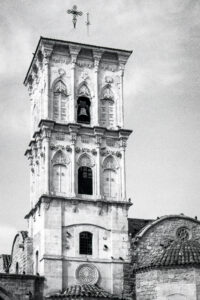Poseidonia Hotel, Limassol, 4th February 1994
Out on the fast road to Larnaca in the white Suzuki Samurai at 8 o’clock, the sunny landscape of south east Cyprus zipping by: lemon groves and ancient olives; dry valleys and ravines; Stavrovouni Monastery dark blue in the haze high up on its crag; blue, yellow and white beehives among the trees; and distant ridge of the snowy Troodos Mountains.
Larnaca announced itself with the Kamares aqueduct, 75 arches of weathered mellow stone built in 1747 to bring water six miles to the city. In the city a rambling old quarter and bazaar, a large covered market and noisy metal workshops under ancient arches. Down by the sea Larnaca Castle with an unkempt green courtyard where cadged birds sang and cannon from the time of the Georges and early 20th century Turkish field guns made by Krupp rusted. Nearby a splendid new paved promenade with lamp standards and palm trees.
Modern building has not yet run riot and the tower of the church of St Lazarus proclaims the faith across the city. The church was built in the late 9th to early 10th Centuries over the claimed site of the burial of Lazarus after his second death. In the chequred history of Cyprus it has been variously an Orthodox and Roman Catholic church and a mosque. The tower was rebuilt in the second half of the 19th Century in an Italianate style. Inside, in the cool and quiet, a riot of gold and glass and icons contrasting with the rough simplicity of the stone. Wax votive offerings – a leg, an arm, a hand, a baby – hang in faithful supplication.
There is a poignant burial ground attached. From the late 1600s until the British occupation of Cyprus in 1878, a small compound was set aside for the burial of Protestant mariners, merchants and, later on, missionaries. It’s a practice found elsewhere in the former Ottoman Empire. Tombstones survive in Larnaca, dating between 1674 and 1849. The stones tell the tales of occasionally great age and too often the briefest of lives.
If envy in my soul could dwell / Child! I could envy thee; / Ere sin its iron chains had forg’d / The captive was set free.
Then shed no tear on such a grave / No mourning vigil keep / Man is not so supremely Blest, / To need for angel Weep.
The memorial for Helena Augusta Jane, daughter of Niven Kerr Esq, Consul for the island, and Louisa Maria, died 3rd July 1847 aged 11 months and 10 days.

